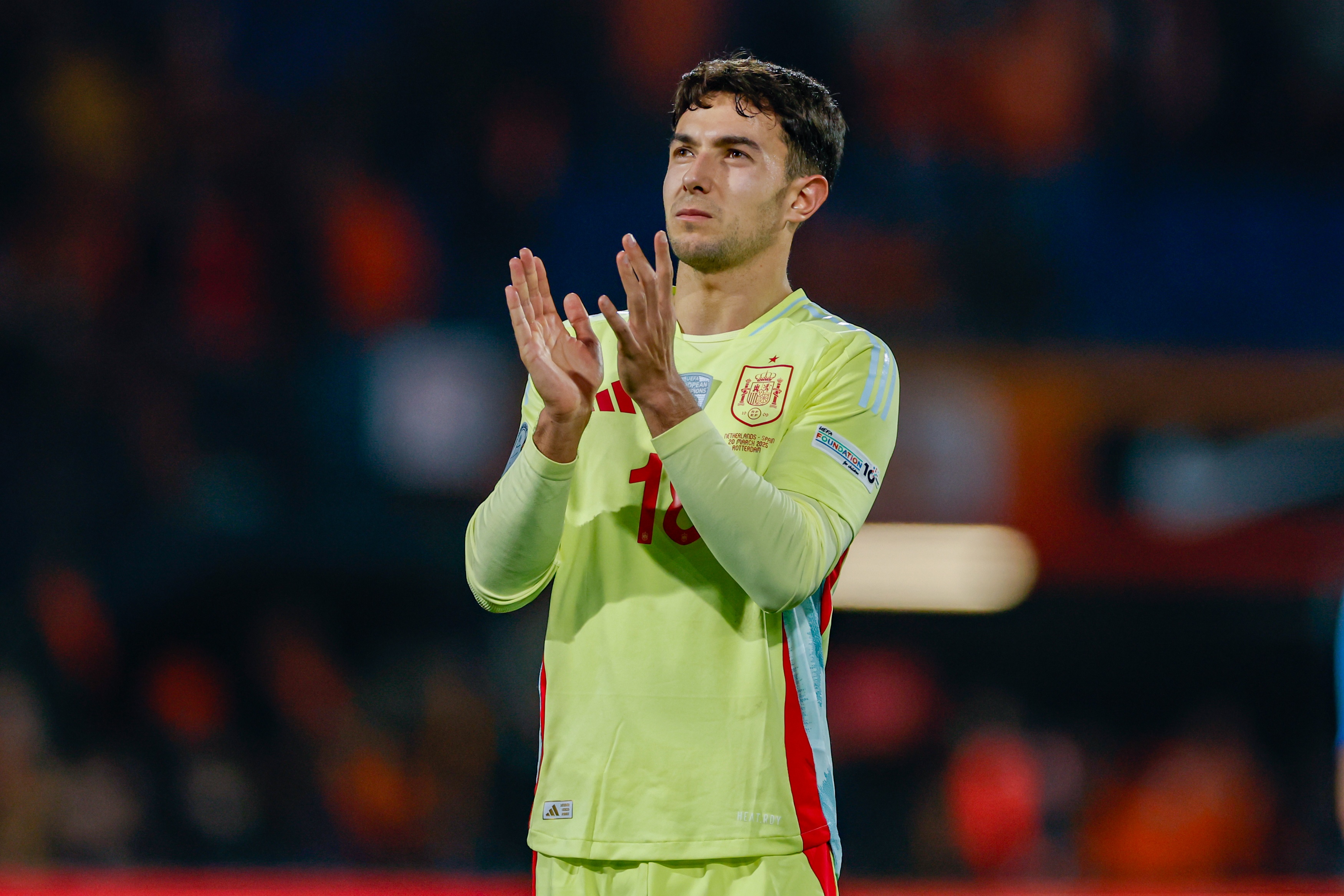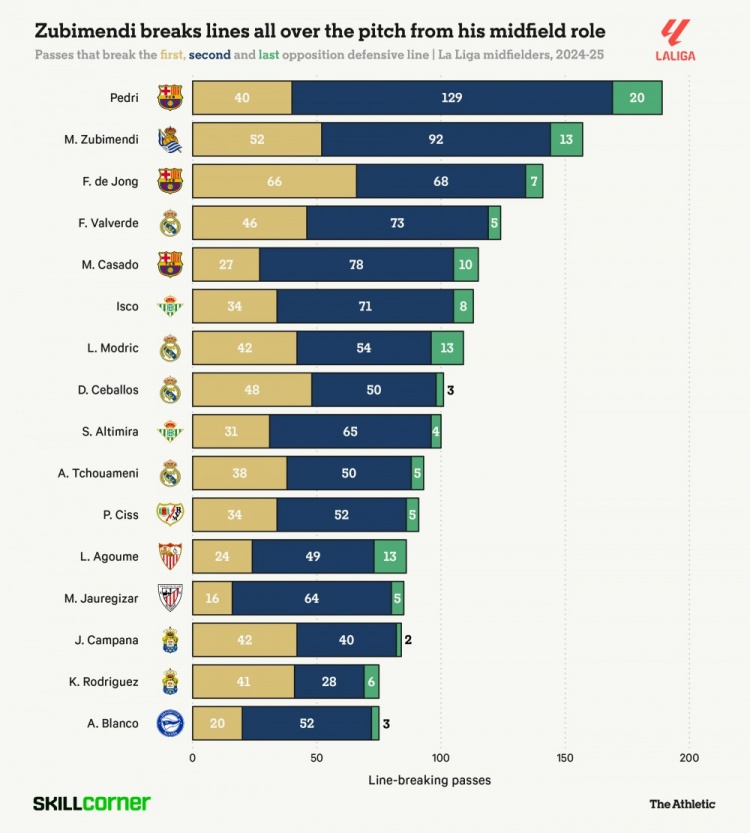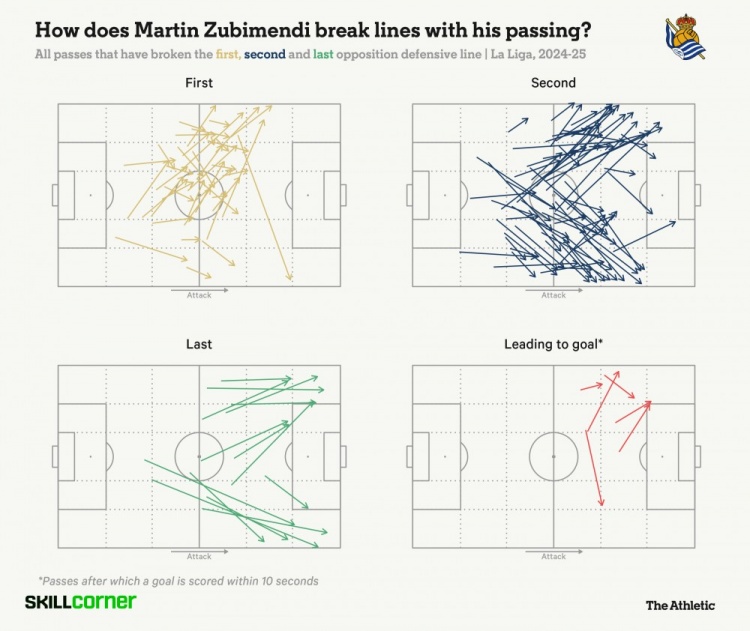Xiaoba Translator Yanjia | Misan or Data Lies? Why is Zubi Mendi not as good as he praises
Why is Zubimendi written in the media different from Zubimendi presented in the statistics? Is it the media that praises it or the statistics that lie? The Athletic author Thom Harris conducted an analysis. With the deepening of football data technology, even if we have never seen a player play football with his own eyes, it is easier to understand his technical characteristics than ever before. Are all kinds of data lying? Why is Zubi Mendi's passing data not as good as the media praises? According to statistical tools, they can easily outline a player's game outline through numbers. However, when evaluating a player's true level, relying solely on event data often lacks the key background provided by naked eye observation. For example, Zubi Mendi, who we are going to talk about today, is just a player with "not good" statistics but performing very well. During his time at Real Sociedad last season, Zubimendi ranked 19th in the number of successful forward passes in La Liga and 27th in pushing and dribbling. His pass success rate is only 84.4%, which does not seem to be enough for a midfielder who is famous for controlling the pace of the game. The reason why Zubimendi's statistics is like this can be explained in part by the limitations of the event data, after all, most data cannot fully capture those passing balls that seem to have actual influence: whether he finds a teammate in an open position, speeds up the pace of the game, or destroys the opponent's formation. But as tracking data progresses, we are able to start exploring how players like Zubi Mendi actually impact the game situation around them and recognize those who can turn the game around but fail to deliver a key last pass. With the help of SkillCorner's data, Thom Harris studied the game video in depth to reveal the truth behind it... As the core of Real Sociedad's ball control system, Zubimendi was the player with the most touches, passes and dribbles in the team last season. His core role is to provide balance for the team. He will roam around the field width, identify when teammates are under pressure or play more with less, and actively act as that extra contact point, and he will not be afraid of being in a difficult situation as long as it helps the team keep the ball running. This means that the data often portrays Zubimendi as a risk-averse passer, maintaining the midfield with a short, safe pass in the half. However, the incident data reveals much more than what is seen on the surface. SkillCorner data shows that nearly 57% of his passes were tried under pressure last season; while only nine midfielders took on a higher percentage of the pressure on the team (9.4%) throughout La Liga. In short, much of what Zubimendi does on the court needs to be done quickly and often faces tightening from his opponents – but he is happy to take most of this pressure on the team. For example, the following case against Valencia is a good explanation of Zubimendi's role: the 26-year-old Spanish international first waited behind the two forwards during the organizational stage, and then moved to the receiving position. Zubimendi created a catch space for himself without much effort. After getting the ball, he quickly accelerated and threw away opponents Xavi Gra and Ugo Duro, and then threw the ball to Sergio Gomez, who turned around to catch the ball, allowing the attack to continue. By traditional definition, Zubimendi's movement here will not be marked as "propelled pass" - a detailed study of the rules will reveal that a propulsion pass cannot start at 40% of the field area on the side's defensive end - but from the viewer's perspective, Zubimendi's rhythm changes and forward passes are extremely transformative, instantly transforming the team from slow organizational advancement to a four-on-four situation in the frontcourt. In the next example against Biba, Zubimendi's performance is more penetrating. He pulled the side to meet the pass from full-back Hamari Traore, a run that was crucial to helping Real Sociedad get rid of radical man-to-man oppression. Although he rescued the team from potential difficulties and launched a quick attack with an adventure touch pass, Zubimendi would also not be recognized by many traditional propulsive pass indicators in this case, as the pass starts too far back. Tracking data also helps bridge the gap between those more invisible links in an organization's offense and data analysis. By placing the game events in the dynamic context of other players on the field (watching how the pass weakens the defensive structure, bypasses the defensive players, get rid of the pressure) we can recognize players who change the pace of the game by sending out potentially overlooked passes. The passes through the defense line are a good entry point, and SkillCorner defines them as those passing, crossing, or bypassing an organized defensive formation to push forward. Last season, Zubimendi ranked high in such passes: as a midfielder, he passed through the defense (157 times) behind Barcelona's Pedri and ranked ninth among La Liga midfielders with 4.7 per game. Zubimendi's pass through the defense line is second only to Pedri In the case against Celta, it shows Zubimendi's exploration spirit when holding the ball. After he retreated between the defenders to receive the response, he sent three passes through the defense in just eight seconds, and finally handed the ball to Pablo Marin with his left foot. Although these passes did not advance significantly in depth, Celta's defenders were constantly forced to leave the position and go forward to put pressure after Zubimendi found the catch point. These are tentative passes that raise questions and ultimately tear open space for the development of the front offense. He can also speed up the pace and play more directly, as shown in the wonderful pass against Valencia below. Similarly, Zubimendi's movement to retreat to the defense eased the organizational pressure and allowed central defender Igor Suvedia to pass the ball more calmly under the pressure of the opponent. The 26-year-old then penetrated two lines of defense with a left foot pass, and Mikel Oyasawar, who was receiving the ball, cleverly opened up the space. This is not technically propulsive passes according to many popular event data sources, but it is an example of Zubi Mendi's bold, forward-looking passes that he doesn't always receive praise for. Of course, he is not always so radical, and there are some games where you can hardly notice that he shuttles through various spaces during the deep organization stage, taking the initiative to help his teammates get out of the predicament. But when Zubimendi finds an opportunity to change the pace, he can do it, and it often has significant results. Drawing Zubimendi's pass through the defense helps further outline his character: he usually first penetrates the first line with a short and sharp pass, and then seeks a long pass to the wing further forward. He often has little participation when sending the ball into the opponent's penalty area. But intuitively speaking, for teams like Arsenal that have a deeper control line, he will get more opportunities to find teammates in dangerous areas near the middle. How did Zubimendi use his pass to tear his opponent's defense? SkillCorner also helps quantify his ability to push forward quickly - he completed 77 "fast" passes through the defense last season (the ball passed in the first time or within a second after receiving the ball). Among the La Liga midfielders, only Real Madrid's Modric and Valverde and Barcelona's Pedri are more than him. Below, the case against Mallorca shows how Zubimendi quickly adjusts his foot movements to get rid of the opponent's defensive dilemma: he and Luca Sucic complete a quick two-pass one, then control the ball with his left foot, and then poke the ball to full-back Muñoz. After pushing the goal through layers of defense, he moved forward with the attack and finally found the winger Barrenecea who was inserted behind him with a pick pass. Below is another example of Zubimendi helping the team to speed up the progress. In this away game against Osasuna, Zubimendi retreated to catch the ball and passed the ball through the midfield defense with a touch pass. Although the pass alone is not a big threat, it is its forward speed that caught the opponent's oppression off guard, allowing teammates who are in a higher position to enter the space. Last season, Rice performed well in Arsenal's drag-back midfield position, but Zubimendi seemed natural in organizing offense. He has the trick to get rid of stress and has an instinctive understanding of when and how to push forward the goal most effectively. Any Arsenal fans who are worried about these seemingly mediocre data, please rest assured: Zubi Mendi actually takes more risks, and the role he plays in promoting the team's offense is far more important than the data seems at first. 



- Recent Posts
-
- Photo News: "No. 1 Black Fan"
- here we go! Romano: Joan Garci
- Tutto: Chiesa’s performance at
- Sky: Arsenal agrees to £13 mil
- Fee A: I am very much looking
- Reporter: Villa and Leipzig ho
- World Sports: Barcelona wants
- Lucio: The burn is caused by a
- The termination fee is 45 mill
- Playoffs - Inter Miami s away
- Hot Posts
-
- Yamal social media posts a vac
- Wyson hugged and greeted Real
- Dimazio: Inter Milan talks abo
- Reporter: Real Madrid hopes to
- 2024-25 Champions League strai
- The first win in the last 5 ro
- Fabian Ruiz scored twice in th
- Teams absent from the Club Wor
- Big brands gather! Infantino,
- Marca: Atletico Madrid intends
- The termination fee is 45 mill
- Reporter: Milan is willing to
- British media: Newcastle has n
- Morning Post: Arsenal official
- Away bug? Atletico Madrid s la
- Stick to 60 million! Photo new
- Desky: Peretz received the sec
- Reporter: Padorin will not joi
- Contract salary 16 million 👀TN
- The big ear cup also requires
- search
-
- Links
-
